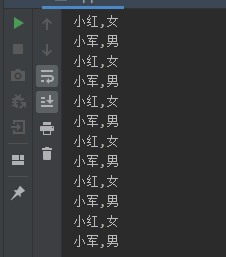preface
1, synchronized and Volatile
- volatile
- Visibility can be guaranteed, but atomicity cannot be guaranteed (thread safety problem)
- Prohibit reordering
- synchronized
- Both visibility and atomicity can be guaranteed
- Reordering is not prohibited
- synchronized is blocking. Only one thread can access it at a time
2, Reorder
- Concept: the cpu will optimize the code implementation and will not reorder the dependent code
- The execution order of the code may change
- However, the results of the implementation will not change
- Data dependency:
- Only for instruction sequences executed in a single processor and operations executed in a single thread
- Data dependencies between different processors and between different threads are not considered by compilers and processors
- Case:
- a and b are independent
- c and a, c and b have dependencies
int a=1; int b=2; int c = a * b;
3, As if serial
- Concept:
- Reorder anyway (compiler and processor to improve parallelism)
- The execution result of a (single threaded) program cannot be changed
- Compiler, runtime and processor must comply with as if serial semantics
- Conclusion:
- The problem of reordering does not exist in a single thread
- Reordering only needs to be considered in the case of multithreading
4, Application of volatile in reordering
- Assume that the following writer and reader are two independent threads
- If a and flag are not decorated with volatile, there is no dependency between a and flag
- The cpu may reorder the code in the writer
- First execute flag = true;, Then execute a = 1;
- This will cause the i result in the reader to be 0, which is contrary to the actual requirements
- Modifying a and flag with volatile can prohibit reordering and ensure the accuracy of running in multithreading
class ReorderExample {
volatile int a = 0;
volatile boolean flag = false;
// Write thread
public void writer() {
a = 1; // 1
flag = true; // 2
}
// 1.1 lines of code and 2 lines of code have no dependencies
// Read thread
public void reader() {
if (flag) { // 3
int i = a * a; // 4 0
}
}
}
5, wait and notify
- wait: pause the currently executing thread and release the resource lock so that other threads can have a chance to run
- notify/notifyall: wake up the thread in the lock pool and make it run
- Requirements for use of wait and notify
- Be sure to execute in synchronized
- Be sure to hold the same lock
// Shared object
class Res {
// full name
public String name;
// Gender
public String sex;
// If it is true, it is allowed to read but not write
// If it is false, it is allowed to write but not read.
public boolean flag = false;
}
// Producer thread
class IntThread extends Thread {
public Res res;
public IntThread(Res res) {
this.res = res;
}
@Override
public void run() {
int count = 0; // 1
while (true) {
synchronized (res) {
if (res.flag) {
try {
res.wait();// Release the current lock object
} catch (Exception e) {
// TODO: handle exception
}
}
if (count == 0) {
res.name = "Xiao Hong";
res.sex = "female";
} else {
res.name = "Xiaojun";
res.sex = "male";
}
count = (count + 1) % 2;// 0 1 0 1 0 1
res.flag = true;// Mark the current thread as waiting
res.notify();// Wake up the waiting thread
}
}
}
}
// Consumer thread
class OutThread extends Thread {
public Res res;
public OutThread(Res res) {
this.res = res;
}
@Override
public void run() {
while (true) {
synchronized (res) {
try {
if (!res.flag) {
res.wait();
}
Thread.sleep(1000);
} catch (Exception e) {
// TODO: handle exception
}
System.out.println(res.name + "," + res.sex);
res.flag = false;
res.notify();
}
}
}
}
public class App {
public static void main(String[] args) {
Res res = new Res();
IntThread intThread = new IntThread(res);
OutThread outThread = new OutThread(res);
intThread.start();
outThread.start();
}
}
Test results: the production thread produces a res and the consumption thread consumes a res
